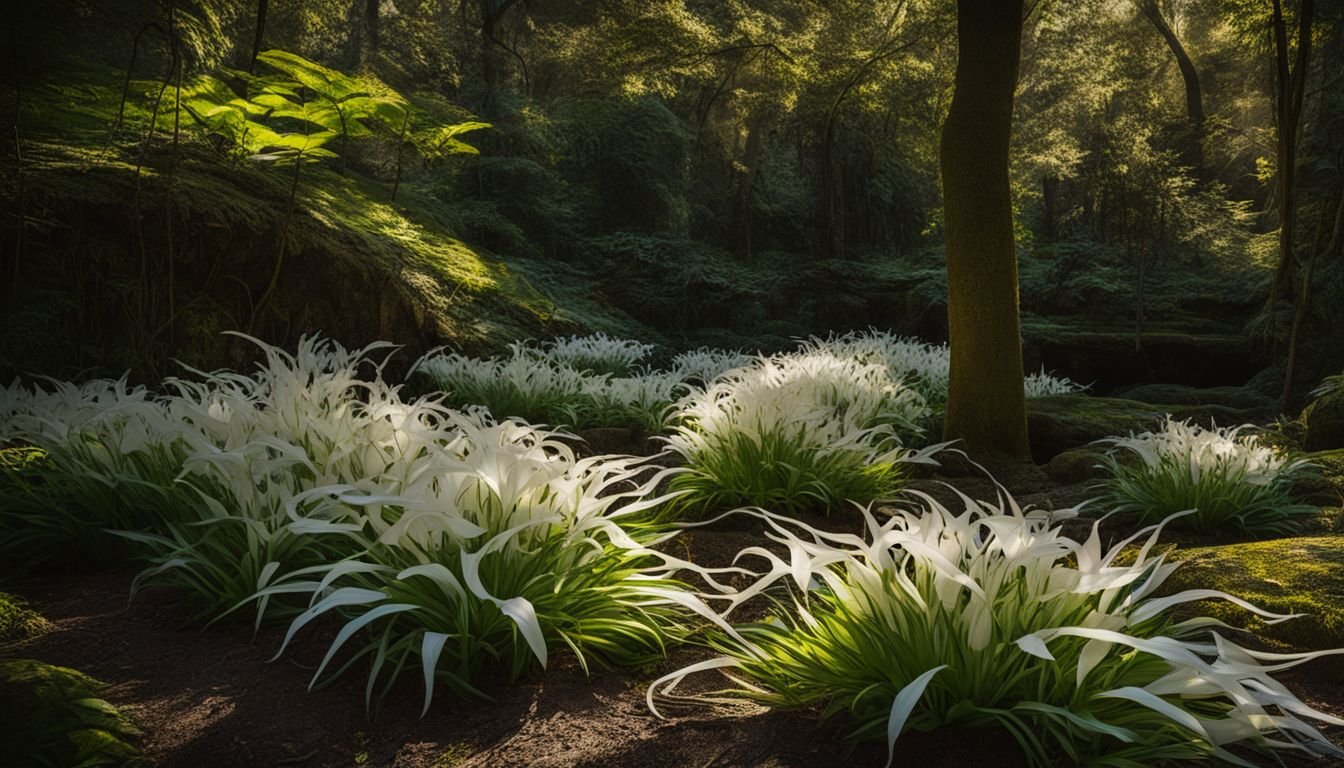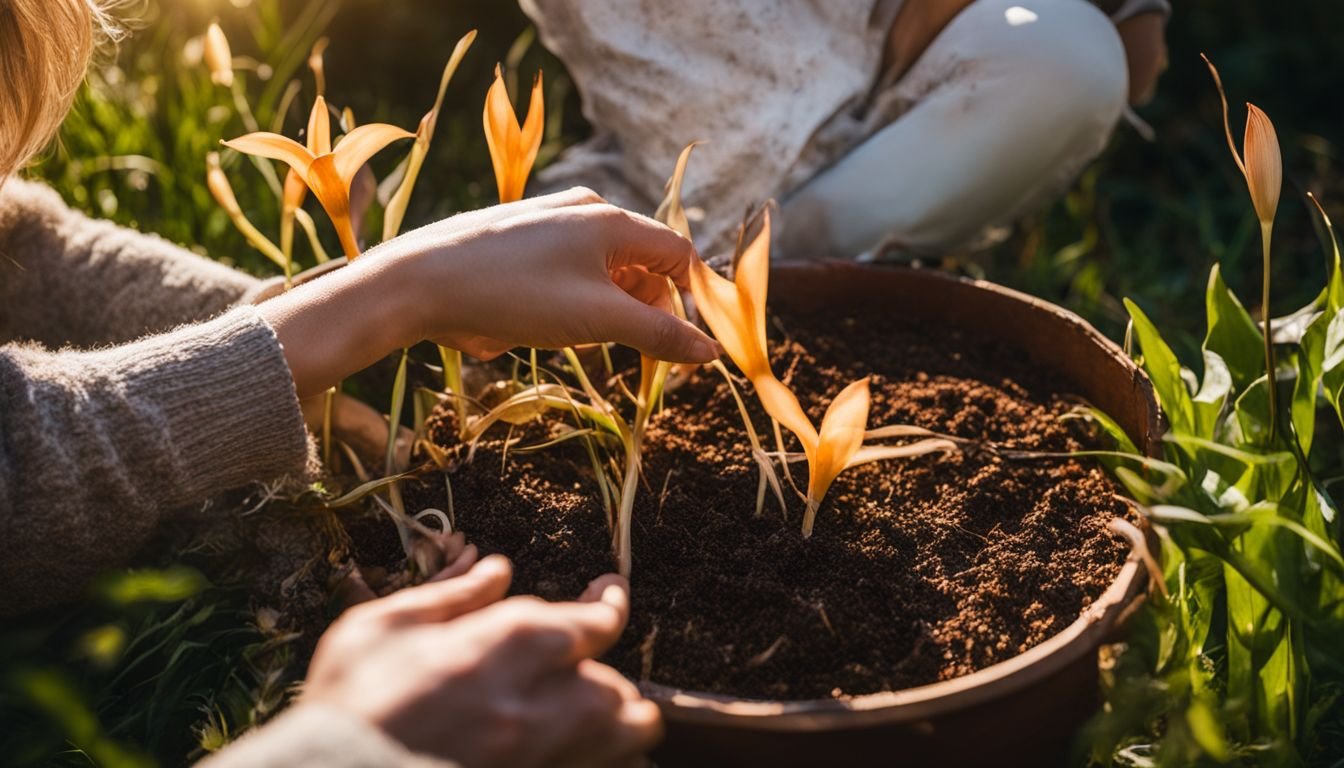Are you having a squiz at a corner of your garden and reckon it’s begging for something special, but can’t put your finger on what? Maybe the Ghost Lily has crossed your mind – that striking plant that can light up any shady nook.
We completely get how you feel; wanting that perfect touch in your garden but not quite nailing down where to begin is something many of us have grappled with. Fortunately, we’ve done our homework to bring you the best tips for growing these stunning flowers right here in Australia.
The Ghost Lily, or Notholirion bulbuliferum for those who like the botanical names, is renowned for its resilience against cooler temperatures and its knack for blooming spectacularly even under the canopy’s shade.
Just knowing this bit makes diving into gardening seem less daunting and way more thrilling. Our guide takes you by the hand – from sowing seeds just right, through to nurturing them into magnificent blooms that’ll inject life and colour into any patch of green.
Keen to sprinkle a bit of gardening magic around? Let’s crack into it!
Key Takeaways
- Ghost Lily plants, also known as Notholirion bulbuliferum, are ideal for Australian gardens due to their frost hardiness down to about -15C and ability to thrive in dappled light under trees.
- Sowing seeds inside punnets or directly into the garden during autumn or winter gives the best chance of germination. Remember to give seeds a cold kick-start with four weeks in the fridge before moving them to a warmer spot.
- Prepare soil by loosening it and mixing in a high-quality seed-starting blend, then keep it consistently damp over four weeks. This creates an ideal environment that helps seeds sprout successfully.
- Caring for Ghost Lily plants includes keeping the soil moist but not waterlogged, using compost or manure to enrich the soil, providing dappled sunlight, protecting from pests like aphids and slugs, and allowing faded stalks to store energy for next season’s blooms.
- If seeds don’t start growing initially, try stratification by storing them in moist material inside your fridge for six weeks. Also ensure seed trays get plenty of light after planting indoors.
Understanding the Ghost Lily Plant in Australia

The Ghost Lily, officially known as Notholirion bulbuliferum, finds its perfect spot in the dappled light and shade under trees and shrubs across Australia. This remarkable bulb thrives through winter’s chill, shooting up to display its splendor with 60cm tall spires come spring.
As a bonus for Australian gardeners, this plant doesn’t shy away from frosty mornings; it stands strong against frosts down to about -15C. Its resilience makes it an ideal pick for those looking for reliable perennials that add a unique charm to their gardens.
We often see these ornamental plants making their way into gardeners’ hearts with ease due to their low maintenance needs. You can sow them indoors in punnets or directly into your garden soil when autumn whispers its arrival or during the coolness of winter.
Ensure they get enough moisture and warmth, preferably in a well-lit spot where temperatures hover between 18-24°C, allowing them to germinate successfully within four weeks. This straightforward approach positions the Ghost Lily as one of Australia’s easiest-to-grow bulbs — truly a gift amongst Asiatic lilies.
“A touch of frost hardiness mixed with blooming brilliance defines the Spirit of Australian gardening.”
Step-by-step Guide to Propagating Ghost Lily Plants

We’ll show you how to grow more Ghost Lily flowers using a simple process. Our guide will lead you through each step, from planting seeds to making sure your plants thrive.
Sowing seeds
Sowing seeds is a great start to grow your Ghost Lily plants. You can sow them in punnets inside any time you like, or directly into the garden during the cooler months of autumn and winter.
This method gives your seeds the best chance to sprout well. Notholirion bulbuliferum, typically known as Ghost Lily, ranks among the simplest and most dependable flower-producing bulbs for seed raising.
The secret lies in giving them a cold kick-start by placing your seeded punnets in the fridge for about four weeks before moving them to a warmer spot.
To get your seeds going, sprinkle them lightly on top of well-drained soil mixed with some John Innes compost if available; this mix ensures good moisture balance without waterlogging your delicate seeds.
Covering lightly with more soil helps keep moisture around the seeds while they begin their journey downwards forming roots and upwards shooting towards light. Do not forget to mark each punnet with plant names because when all those little green shoots start popping up, it’s easy to lose track! Keep an eye on moisture levels but avoid overwatering – young plants love damp surroundings but they hate swimming.
Carefully watch for signs of germination which might take several weeks depending on conditions such as temperature and light exposure during growing season; patience truly pays off here! As tiny leaves appear, celebrate these first steps towards adding beautiful Asiatic lilies or even charming dwarf varieties to your garden space filled with vibrant colours and life.
Preparing the soil
We start by choosing a shady spot in the garden because our Ghost Lily plants love dappled sunlight under trees and bushes. This ensures they get just the right amount of light without being overwhelmed by the harsh Australian sun.
We dig up the chosen area gently, making it loose and airy for our lilies to breathe and stretch their roots comfortably.
Next, we mix in a high-quality seed-starting blend with the native earth. This creates an ideal environment that retains moisture yet drains well, preventing water from pooling around delicate roots.
We keep this ground consistently damp over four weeks to support sprouting seeds, adding a thin layer of sand or fine gravel on top to help conserve moisture without burying them deep.
Making sure our soil is ready sets the stage for healthy growth and beautiful blooms of asiatic lily and dwarf asiatic lily among other beloved garden specimens like herbs and hostas.
Plant care and maintenance
Caring for your Ghost Lily plants is crucial to see them thrive in Australia. Let’s walk through some key steps to keep these garden beauties healthy.
- Ensure the soil stays moist but not waterlogged. Use a watering can to gently soak the soil around your lilies, especially during dry spells.
- Plant Ghost Lilies in humus-rich soil for best results. Adding compost or well-rotted manure boosts soil fertility and structure.
- Position your plants where they get dappled sunlight throughout the day. They love the light but need protection from harsh afternoon sun.
- Keep an eye out for pests like aphids and slugs that might fancy your lilies. A gentle spray with insecticidal soap usually keeps aphids at bay, while organic slug pellets can deter slugs.
- Bulblets will form; these are baby bulbs branching off the main one. Carefully remove and plant them elsewhere if you want more Ghost Lilies.
- After flowering, don’t rush to cut back the faded stalks – they store energy for next season’s blooms. Wait until they turn brown before pruning.
- Mulch around the base with straw or bark chips to maintain moisture levels and discourage weed growth.
Moving onto how we tackle common issues that might crop up, let’s ensure our Ghost Lilies remain stunning year after year.
Troubleshooting Common Issues in Ghost Lily Propagation
Sometimes, Ghost Lily seeds seem stubborn and won’t start growing. To solve this, give them a cold treatment known as stratification. Store the seeds in moist material like sand inside your fridge for six weeks.
This tricks them into thinking they’ve been through winter, encouraging them to germinate when planted. Also, keeping seed trays at consistent moisture levels and temperatures between 18-24°C boosts their chances of sprouting.
A common mistake is not providing enough light after planting the seeds indoors. Place seed containers in a spot where they can soak up plenty of sunshine for four weeks to help them grow strong.
If frost threatens your outdoor plants, remember that Ghost Lilies can handle cold down to about -15C but might need some protection in harsher weather or less ideal conditions. By following these tips, you increase your success rate with these garden beauties.
Recommended Resources for Australian Gardeners
For Australian gardeners keen on adding ghost lilies to their oasis, Plant Addicts is a treasure chest of choices. They stock the Tiny Ghost Lily among other garden plants, making it easy to find exactly what you need.
Their team offers stellar support through chat, email, and phone all week long. This means help is always at hand if you run into any issues or just need advice on which lily bulbs will best suit your garden’s vibe.
Gardening forums also prove invaluable for those of us looking to exchange tips and tricks specifically about sowing seeds or keeping our plant friends happy. Websites such as Gardening Australia provide heaps of information tailored to our local climate and soil types.
These platforms are not just about solving problems; they’re where passionate plant lovers gather to share their successes and inspire others with their lush gardens.
Now let’s delve into wrapping up our journey with ghost lilies in Australia.
Conclusion
We’ve shown you the steps to start your Ghost Lily journey in Australia. From sowing seeds to dealing with common issues, we covered it all. You now know this plant loves the shade and needs soil full of old leaves and compost.
Don’t forget, planting bulbs 10cm deep helps them thrive. Keep an eye on those young plants over winter for a beautiful bloom in spring. With care, your garden will soon be full of these ghostly beauties year after year.
So grab your gardening tools and get started today!
FAQs
1. What is the first step to propagate Ghost Lily plants in Australia?
The first step is to get your Ghost Lily seeds ready to be sown into well-draining soil, ensuring they have the perfect start.
2. How often should I water my newly sown Ghost Lily seeds?
Water your sown seeds gently but consistently, keeping the soil moist without making it too soggy.
3. When will I see growth in my sown Ghost Lily plants?
After sowing, expect to see sprouts within a few weeks as long as you provide them with enough sunlight and keep the soil conditions right.
4. Can I plant my Ghost Lilies outside after they’ve grown?
Yes! Once your Ghost Lilies have established themselves indoors, you can transplant them outside where they’ll continue to thrive in Australia’s climate.
